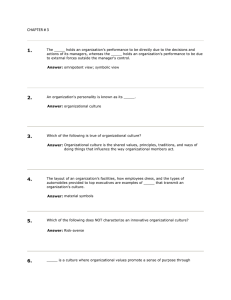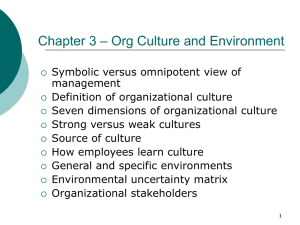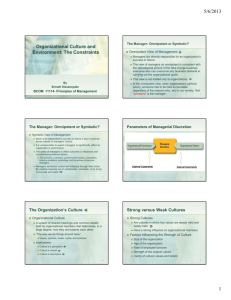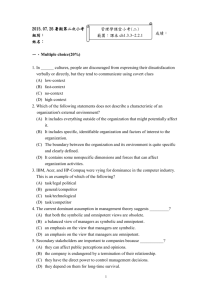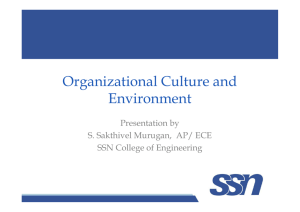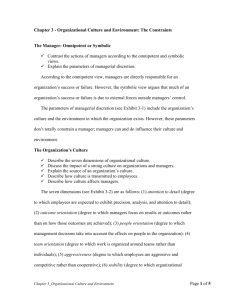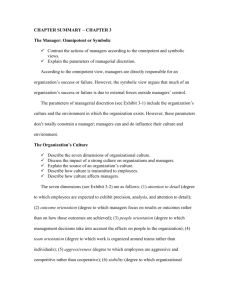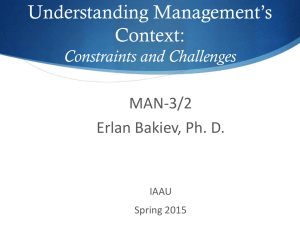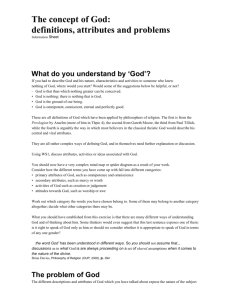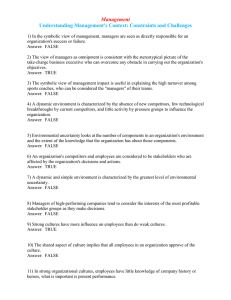Management's Context: Constraints & Challenges Presentation
advertisement
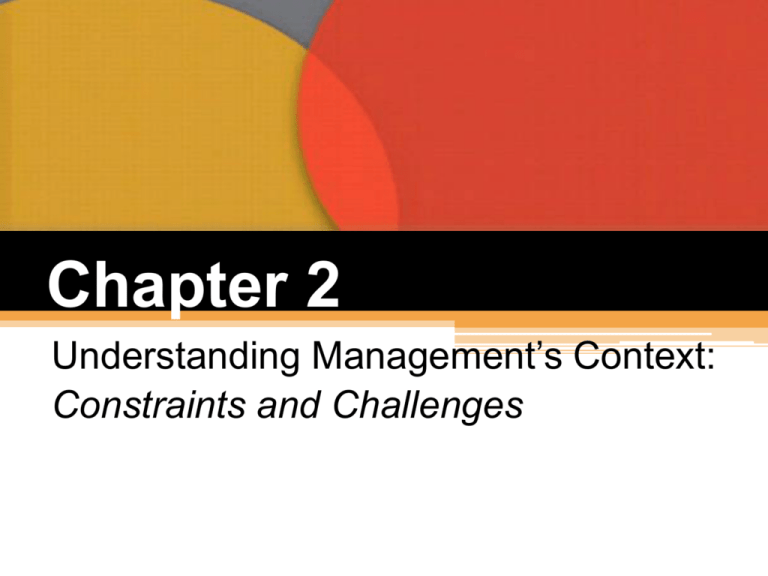
Chapter 2 Understanding Management’s Context: Constraints and Challenges The Manager: Omnipotent or Symbolic? Omnipotent view of management: The dominant view in management theory and society in general is that managers are directly responsible for an organization’s success or failure. Symbolic view of management: The view in management theory that much of an organization’s success or failure is due to external forces outside managers’ control The Manager: Omnipotent or Symbolic The Omnipotent View: Good managers anticipate change, exploit opportunities, correct poor performance and lead their organizations When profits are up, credit goes to manager and he gets reward or bonuses When profits go down, managers are blamed and fired Example: Sports team coaches The Manager: Omnipotent or Symbolic The Symbolic View: Company performance depends on external factors like Economy Customers Government Competitors Industry conditions Example: Cisco Systems: When performance went down analysts blamed their acquisition strategies and customer service The External Environment: Constraints and Challenges Economic Global Political/ Legal Social/ Cultural Technological Demographics The External Environment: Constraints and Challenges Economic Environment: Global Economic Recession Job cutting Lack of credits available to fund business activities Example: General Motors (GM) got bankrupted due to economic condition. In such situation managers will not be blamed. Thus it became a symbolic view Economic Inequality Widening Income Gap Example: RMG sector protest in BD The External Environment: Constraints and Challenges Demographic Environment: Baby Boomers: (1946-1964) Very large in population, that’s why they are called boomers They changed educational system, entertainment and lifestyle Generation Y: (1978-1994) Changed technology and clothing style Generation Z or Post Millennial (2000-present): Also called i-generation Brought up with technologies Example: Kindle vs ipad or Nexus/ Sony Walkman vs ipod/ Facebook employees How the External Environment Affects Managers Jobs and Employment: Recession: Lost millions of jobs Many companies prefer freelancers Example: Current political instability of BD Assessing Environmental Uncertainty: Dynamic Environment: When environment changes frequently and unpredictably. Example: Music industry Stable environment: When change is minimal and expected/predictable. Example: US departmental stores: tend to have low sales from December to January How the External Environment Affects Managers Assessing Environmental Uncertainty: Environmental Complexity: Fewer competitors, customers, suppliers means less complex environment. Example: Unilever vs Diamond world Managing Stakeholder Relationship: Stakeholders: Constituencies in the organization's environment that are affected by an organization’s decisions and actions Managing stakeholders can lead to: Successful innovations Predictability of the environmental changes Greater degree of trust among stakeholders Greater organizational flexibility Higher organizational performance Organizational Culture Organizational Culture means shared values, principles, traditions, and ways of doing things that influence the way organizational members act Culture isA perception: Can’t be physically touched or seen Descriptive: Can’t be expressed in one word Example: Public University vs NSU Organizational Subculture: Example: NSU English Department vs Finance Dept. Strong and Weak Culture Strong cultures are those in which the key values are deeply held and widely shared and have a greater influence on employees Example: Google culture Weak cultures are those in which the key values are only limited to few people (mostly the top management) and don’t have much influence on the employees Example: Stardust and Persona Strong Versus Weak Culture How Employees Learn Culture Stories Rituals: Example: Award ceremony Material Art and Symbols: Feel of the environment of a workplace Language Current Issues in Organizational Culture Creating an Innovative Culture Challenge and involvement – Are employees involved in, motivated by, and committed to long-term goals and success of the organization? Freedom – Can employees independently define their work, exercise discretion, and take initiative in their day-to-day activities? Trust and openness – Are employees supportive and respectful to each other? Idea time – Do individuals have time to elaborate on new ideas before taking action? Current Issues in Organizational Culture Creating an Innovative Culture Playfulness/humor – Is the workplace spontaneous and fun? Conflict resolution – Do individuals make decisions and resolve issues based on the good of the organization versus personal interest? Debates – Are employees allowed to express opinions and put forth ideas for consideration and review? Risk-taking – Do managers tolerate uncertainty and ambiguity, and are employees rewarded for taking risks? Current Issues in Organizational Culture Creating a Customer Responsive Culture Current Issues in Organizational Culture Spirituality and Organizational Culture workplace spirituality: It’s a culture in which organizational values promote a sense of purpose through meaningful work taking place in the context of community Characteristics of Cultural Spirituality: Strong sense of purpose Focus on individual development Trust and openness Employee empowerment Toleration of employee expression

